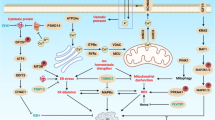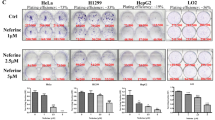Abstract
To address the question of whether established or experimental anticancer chemotherapeutics can exert their cytotoxic effects by autophagy, we performed a high-content screen on a set of cytotoxic agents. We simultaneously determined parameters of autophagy, apoptosis and necrosis on cells exposed to ∼1400 compounds. Many agents induced a ‘pure’ autophagic, apoptotic or necrotic phenotype, whereas less than 100 simultaneously induced autophagy, apoptosis and necrosis. A systematic analysis of the autophagic flux induced by the most potent 80 inducers of GFP-LC3 puncta among the NCI panel agents showed that 59 among them truly induced autophagy. The remaining 21 compounds were potent inducers of apoptosis or necrosis, yet failed to stimulate an autophagic flux, which were characterized as microtubule inhibitors. Knockdown of ATG7 was efficient in preventing GFP-LC3 puncta, yet failed to attenuate cell death by the agents that induce GFP-LC3 puncta. Thus there is not a single compound that would induce cell death by autophagy in our screening, underscoring the idea that cell death is rarely, if ever, executed by autophagy in human cells.
This is a preview of subscription content, access via your institution
Access options
Subscribe to this journal
Receive 50 print issues and online access
$259.00 per year
only $5.18 per issue
Buy this article
- Purchase on Springer Link
- Instant access to full article PDF
Prices may be subject to local taxes which are calculated during checkout






Similar content being viewed by others
References
Akdemir F, Farkas R, Chen P, Juhasz G, Medved'ova L, Sass M et al. (2006). Autophagy occurs upstream or parallel to the apoptosome during histolytic cell death. Development 133: 1457–1465.
Alexander A, Cai SL, Kim J, Nanez A, Sahin M, MacLean KH et al. (2010). ATM signals to TSC2 in the cytoplasm to regulate mTORC1 in response to ROS. Proc Natl Acad Sci USA 107: 4153–4158.
Arlin ZA, Feldman EJ, Cook P, Ahmed T, Mittelman A, Chun HG et al. (1992). Amsacrine retains a special role supporting Food and Drug Administration approval. J Clin Oncol 10: 169.
Bellot G, Garcia-Medina R, Gounon P, Chiche J, Roux D, Pouyssegur J et al. (2009). Hypoxia-induced autophagy is mediated through hypoxia-inducible factor induction of BNIP3 and BNIP3L via their BH3 domains. Mol Cell Biol 29: 2570–2581.
Berry DL, Baehrecke EH . (2007). Growth arrest and autophagy are required for salivary gland cell degradation in Drosophila. Cell 131: 1137–1148.
Bjorkoy G, Lamark T, Pankiv S, Overvatn A, Brech A, Johansen T . (2009). Monitoring autophagic degradation of p62/SQSTM1. Methods Enzymol 452: 181–197.
Boya P, Gonzalez-Polo RA, Casares N, Perfettini JL, Dessen P, Larochette N et al. (2005). Inhibition of macroautophagy triggers apoptosis. Mol Cell Biol 25: 1025–1040.
Boyce M, Bryant KF, Jousse C, Long K, Harding HP, Scheuner D et al. (2005). A selective inhibitor of eIF2alpha dephosphorylation protects cells from ER stress. Science 307: 935–939.
Carmona-Gutierrez D, Madeo F . (2006). Yeast unravels epigenetic apoptosis control: deadly chat within a histone tail. Mol Cell 24: 167–169.
Criollo A, Senovilla L, Authier H, Maiuri MC, Morselli E, Vitale I et al. (2010). The IKK complex contributes to the induction of autophagy. EMBO J 29: 619–631.
Degenhardt K, Mathew R, Beaudoin B, Bray K, Anderson D, Chen G et al. (2006). Autophagy promotes tumor cell survival and restricts necrosis, inflammation, and tumorigenesis. Cancer Cell 10: 51–64.
Degterev A, Yuan J . (2008). Expansion and evolution of cell death programmes. Nat Rev Mol Cell Biol 9: 378–390.
Edinger AL, Thompson CB . (2004). Death by design: apoptosis, necrosis and autophagy. Curr Opin Cell Biol 16: 663–669.
Golstein P, Aubry L, Levraud JP . (2003). Cell-death alternative model organisms: why and which? Nat Rev Mol Cell Biol 4: 798–807.
Golstein P, Kroemer G . (2007). Cell death by necrosis: towards a molecular definition. Trends Biochem Sci 32: 37–43.
Gonzalez-Polo RA, Boya P, Pauleau AL, Jalil A, Larochette N, Souquere S et al. (2005). The apoptosis/autophagy paradox: autophagic vacuolization before apoptotic death. J Cell Sci 118: 3091–3102.
Gottlieb RA, Mentzer RM . (2010). Autophagy during cardiac stress: joys and frustrations of autophagy. Annu Rev Physiol 72: 45–59.
Harhaji-Trajkovic L, Vilimanovich U, Kravic-Stevovic T, Bumbasirevic V, Trajkovic V . (2009). AMPK-mediated autophagy inhibits apoptosis in cisplatin-treated tumor cells. J Cell Mol Med 13: 3644–3654.
Kabeya Y, Mizushima N, Ueno T, Yamamoto A, Kirisako T, Noda T et al. (2000). LC3, a mammalian homologue of yeast Apg8p, is localized in autophagosome membranes after processing. EMBO J 19: 5720–5728.
Karantza-Wadsworth V, Patel S, Kravchuk O, Chen G, Mathew R, Jin S et al. (2007). Autophagy mitigates metabolic stress and genome damage in mammary tumorigenesis. Genes Dev 21: 1621–1635.
Kerr JF, Wyllie AH, Currie AR . (1972). Apoptosis: a basic biological phenomenon with wide-ranging implications in tissue kinetics. Br J Cancer 26: 239–257.
Klionsky DJ, Abeliovich H, Agostinis P, Agrawal DK, Aliev G, Askew DS et al. (2008). Guidelines for the use and interpretation of assays for monitoring autophagy in higher eukaryotes. Autophagy 4: 151–175.
Korolchuk VI, Mansilla A, Menzies FM, Rubinsztein DC . (2009). Autophagy inhibition compromises degradation of ubiquitin–proteasome pathway substrates. Mol Cell 33: 517–527.
Kroemer G, Galluzzi L, Vandenabeele P, Abrams J, Alnemri ES, Baehrecke EH et al. (2009). Classification of cell death: recommendations of the Nomenclature Committee on Cell Death 2009. Cell Death Differ 16: 3–11.
Kroemer G, Jaattela M . (2005). Lysosomes and autophagy in cell death control. Nat Rev Cancer 5: 886–897.
Kroemer G, Marino G, Levine B . (2010). Autophagy and the integrated stress response. Mol Cell 40: 280–293.
Kroemer G, Levine B . (2008). Autophagic cell death: the story of a misnomer. Nat Rev Mol Cell Biol 9: 1004–1010.
Lee CY, Baehrecke EH . (2001). Steroid regulation of autophagic programmed cell death during development. Development 128: 1443–1455.
Lee JS, Li Q, Lee JY, Lee SH, Jeong JH, Lee HR et al. (2009). FLIP-mediated autophagy regulation in cell death control. Nat Cell Biol 11: 1355–1362.
Levine B, Kroemer G . (2008). Autophagy in the pathogenesis of disease. Cell 132: 27–42.
Lipinski MM, Hoffman G, Ng A, Zhou W, Py BF, Hsu E et al. (2010). A genome-wide siRNA screen reveals multiple mTORC1 independent signaling pathways regulating autophagy under normal nutritional conditions. Dev Cell 18: 1041–1052.
Livesey KM, Tang D, Zeh HJ, Lotze MT . (2009). Autophagy inhibition in combination cancer treatment. Curr Opin Investig Drugs 10: 1269–1279.
Lu Z, Luo RZ, Lu Y, Zhang X, Yu Q, Khare S et al. (2008). The tumor suppressor gene ARHI regulates autophagy and tumor dormancy in human ovarian cancer cells. J Clin Invest 118: 3917–3929.
Maiuri MC, Le Toumelin G, Criollo A, Rain JC, Gautier F, Juin P et al. (2007). Functional and physical interaction between Bcl-X(L) and a BH3-like domain in Beclin-1. EMBO J 26: 2527–2539.
Mizushima N, Levine B, Cuervo AM, Klionsky DJ . (2008). Autophagy fights disease through cellular self-digestion. Nature 451: 1069–1075.
Mizushima N, Yamamoto A, Matsui M, Yoshimori T, Ohsumi Y . (2004). in vivo analysis of autophagy in response to nutrient starvation using transgenic mice expressing a fluorescent autophagosome marker. Mol Biol Cell 15: 1101–1111.
Mizushima N, Yoshimori T, Levine B . (2010). Methods in mammalian autophagy research. Cell 140: 313–326.
Monga M, Sausville EA . (2002). Developmental therapeutics program at the NCI: molecular target and drug discovery process. Leukemia 16: 520–526.
Moreau K, Luo S, Rubinsztein DC . (2010). Cytoprotective roles for autophagy. Curr Opin Cell Biol 22: 206–211.
Pattingre S, Tassa A, Qu X, Garuti R, Liang XH, Mizushima N et al. (2005). Bcl-2 antiapoptotic proteins inhibit Beclin 1-dependent autophagy. Cell 122: 927–939.
Radhakrishnan SK, Bhat UG, Hughes DE, Wang IC, Costa RH, Gartel AL . (2006). Identification of a chemical inhibitor of the oncogenic transcription factor forkhead box M1. Cancer Res 66: 9731–9735.
Saeed AI, Sharov V, White J, Li J, Liang W, Bhagabati N et al. (2003). TM4: a free, open-source system for microarray data management and analysis. Biotechniques 34: 374–378.
Samara C, Syntichaki P, Tavernarakis N . (2008). Autophagy is required for necrotic cell death in Caenorhabditis elegans. Cell Death Differ 15: 105–112.
Shen S, Kepp O, Martins I, Vitale I, Souquere S, Castedo M et al. (2010). Defective autophagy associated with LC3 puncta in epothilone-resistant cancer cells. Cell Cycle 9: 377–383.
Shimizu S, Kanaseki T, Mizushima N, Mizuta T, Arakawa-Kobayashi S, Thompson CB et al. (2004). Role of Bcl-2 family proteins in a non-apoptotic programmed cell death dependent on autophagy genes. Nat Cell Biol 6: 1221–1228.
Shimizu S, Konishi A, Nishida Y, Mizuta T, Nishina H, Yamamoto A et al. (2010). Involvement of JNK in the regulation of autophagic cell death. Oncogene 29: 2070–2082.
Shintani T, Klionsky DJ . (2004). Autophagy in health and disease: a double-edged sword. Science 306: 990–995.
Steller H . (2008). Regulation of apoptosis in Drosophila. Cell Death Differ 15: 1132–1138.
Tsujimoto Y, Shimizu S . (2005). Another way to die: autophagic programmed cell death. Cell Death Differ 12 (Suppl 2): 1528–1534.
Turcotte S, Chan DA, Sutphin PD, Hay MP, Denny WA, Giaccia AJ . (2008). A molecule targeting VHL-deficient renal cell carcinoma that induces autophagy. Cancer Cell 14: 90–102.
Webb JL, Ravikumar B, Rubinsztein DC . (2004). Microtubule disruption inhibits autophagosome–lysosome fusion: implications for studying the roles of aggresomes in polyglutamine diseases. Int J Biochem Cell Biol 36: 2541–2550.
Xia HG, Zhang L, Chen G, Zhang T, Liu J, Jin M et al. (2010). Control of basal autophagy by calpain1 mediated cleavage of ATG5. Autophagy 6: 61–66.
Yu L, McPhee CK, Zheng L, Mardones GA, Rong Y, Peng J et al. (2010). Termination of autophagy and reformation of lysosomes regulated by mTOR. Nature 465: 942–946.
Yuan J, Horvitz HR . (2004). A first insight into the molecular mechanisms of apoptosis. Cell 116: S53–S56, 1 p following S59.
Zhang L, Yu J, Pan H, Hu P, Hao Y, Cai W et al. (2007). Small molecule regulators of autophagy identified by an image-based high-throughput screen. Proc Natl Acad Sci USA 104: 19023–19028.
Acknowledgements
GK is supported by the Ligue Nationale contre le Cancer (Equipes labellisée), Agence Nationale pour la Recherche (ANR), European Commission (Active p53, Apo-Sys, ChemoRes, ApopTrain), Fondation pour la Recherche Médicale (FRM), Fondation Bettencourt-Schueller, Institut National du Cancer (INCa) and Cancéropôle Ile-de-France. SS is supported by European Commission Apo-Sys and IM is supported by La Ligue contre le Cancer.
Author information
Authors and Affiliations
Corresponding author
Ethics declarations
Competing interests
The authors declare no conflict of interest.
Additional information
Supplementary Information accompanies the paper on the Oncogene website
Rights and permissions
About this article
Cite this article
Shen, S., Kepp, O., Michaud, M. et al. Association and dissociation of autophagy, apoptosis and necrosis by systematic chemical study. Oncogene 30, 4544–4556 (2011). https://doi.org/10.1038/onc.2011.168
Received:
Revised:
Accepted:
Published:
Issue Date:
DOI: https://doi.org/10.1038/onc.2011.168
Keywords
This article is cited by
-
A proteome-wide atlas of drug mechanism of action
Nature Biotechnology (2023)
-
The regulation, function, and role of lipophagy, a form of selective autophagy, in metabolic disorders
Cell Death & Disease (2022)
-
Autophagic flux inhibition enhances cytotoxicity of the receptor tyrosine kinase inhibitor ponatinib
Journal of Experimental & Clinical Cancer Research (2020)
-
Effects and Mechanisms of Autophagy Induced by Solubilized-Cholesterol in Hepatocytes: A Comparative Study Among Solvents
Cell Biochemistry and Biophysics (2020)
-
HSP90AA1-mediated autophagy promotes drug resistance in osteosarcoma
Journal of Experimental & Clinical Cancer Research (2018)



